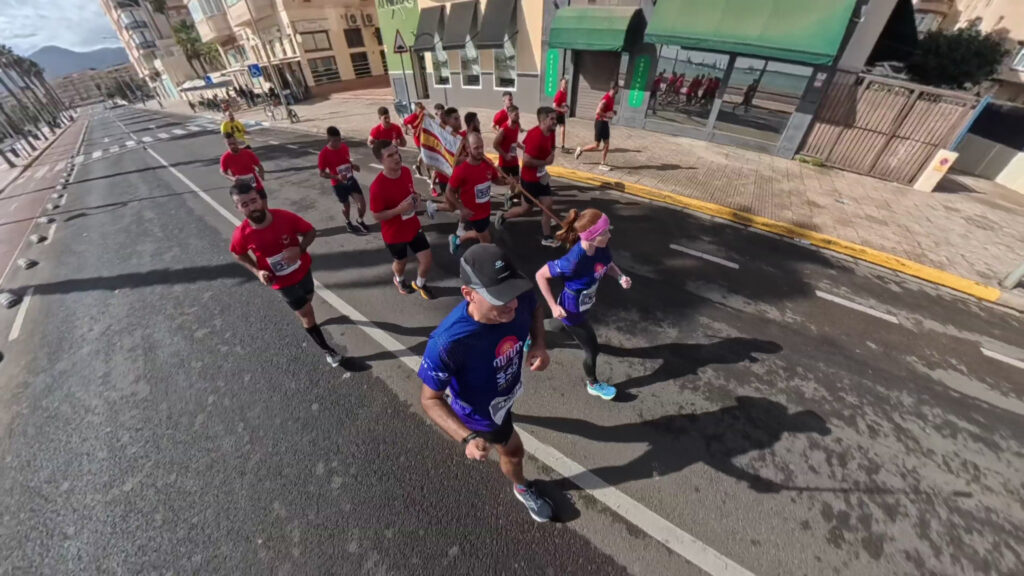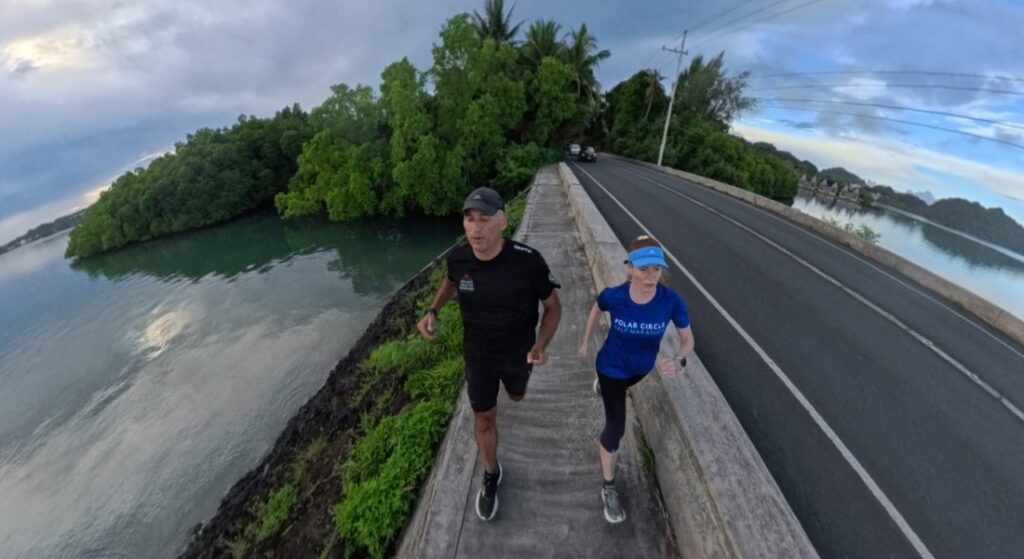Reykjavik, Iceland. August 2023.
Reykjavik proved to be ideal for running, with a scenic course across the old harbor, the true heart of the city, to which we added climbing the Thufa and the hill where the magnificent Hallgrimskirja church is located.
The trip
In August 2023 we traveled to Iceland for the Iceland Volcano Marathon. As we were lucky enough to experience plenty of things and run both in Reykjavik and the crater of the Hverfjall, I have written two posts for the trip: this one, about Reykjavik and its surroundings, (including the Golden Circle), and the other about our days in Myvatn and the race itself, organized by Albatros Adventure Marathons.
Our first epic experience was the midnight sun. And it is kind of magical, but weird. Your body expects the night to fall, but you get an endless golden afternoon. Luckily, all hotels in Iceland have opaque curtains. They also have very good tap water, although the hot one does smell quite a bit of sulfur.
We landed and took a bus that takes 45 minutes from Keflavík to Reykjavik, with a 10% discount for Albatross Marathon participants. The ride is nice as you already get to see the magnificent landscapes of Iceland: all that fiery barrenness.

Hallgrimskirja
Reykjavik is not a vast capital, so our means of transport was.. our legs 😏. We walked first, and ran later, and we enjoyed our sightseeing a lot. Our first stop was, obviously, the famous church Hallgrimskirja, with its very distinctive curved side wings. It was completed in 1986 and it is dedicated to an Icelandic poet and Lutheran pastor. We were impressed by its architecture and we went up its tower to get a magnificent view of the city. It was an extremely sunny day and we could contemplate the bright colors of Reykjavik’s houses and roofs, contrasting with the gray mountains and the deep blue sea. It was a sight to behold!
Light, more light!”
But the closer the priest came to his goal, the less man there was in him, the more beast
Sjón

📝 Tip: Don’t get scared / cover your ears for the very loud bells that sound every 15 minutes.
We then visited the Old Harbour, but I will explain this in the run section, since we came back later to the area when we were running.
The Golden Circle Tour
We also did a tour of the famous “Golden Circle”, the most famous scenic route in Iceland. This was an optional excursion organized by Albatros, and we were glad we had booked it. The tour took around 6 hours and we came back to our hotel after 10pm, but there was light so it felt like it was mid afternoon.
The tour included the Pingvellir National park, Geysir Geothermal Area, and the amazing Gullfoss waterfall. Words fail me to describe all that natural beauty. Miles and miles of gray / brown mountains with patches of deep blue, and crystal streams zigzagging through them. Honestly, the Gullfoss waterfall must be one of the most beautiful places I have ever seen. It’s a natural palace of baroque falls, with clouds of water emerging and the guttural sound of nature, and the river having created a pass through dark mountains.

Btw, during the tour, we passed by Halldor Laxness’ house, 1955’s Nobel Prize winner; I recommend some of his books. Curiously, it was the first private house in Iceland with a private pool!
During the tour, our guide explained to us many interesting facts about Iceland. Some, quite funny, like the local joke about how short the trees are here:
“What do you do if you get lost in an Icelandic forest? You stand up”
But the fact that really caught my attention was that the redhead population 🦰in Iceland is higher than that of other Scandinavian countries, and recent studies have proved that it is due to the vikings taking redhead women as loot in their raids. 😢 Quite sad, but they would go to Celtic areas and kidnap “women and cattle”.
The Drowning Pit…
We also passed by a sad place that deeply impressed me; I could swear that I felt the despair and anger that the “drowning pit” conjures. In there, for centuries women who got pregnant out of wedlock were drowned. Even if they had been raped.
Luckily we moved over to other, more cheerful stories, like the folk legend in Gullfoss waterfall about two lovers, who lived on opposite sides of the river and got married after the guy – supposedly – crossed it. Our guide claimed that three of his grandchildren are descendants of the happy couple… 🤔
🍜 Eating: carb loading and recovery
We saw Icelandic Lamb 🍗promoted already in Icelandair’s ads, and we were lucky that our hotel was close to one restaurant that serves delicious dishes like lamb ribeye or lamb ceviche: Reykjavik Kitchen. Lamb is not only high quality protein, but is a fantastic source of iron! So ideal to recover your muscles after your runs.
Icelandic Lobster/Langoustine 🍤, also known as Humar, is also a traditional fish, and there are many small, modern and traditional restaurants in the old harbor. They prepare it in multiple ways.
🏃♀️The run
We looked for a nice course for an easy run, to stretch our legs before the race.
And we found it. Reykjavik’s in August turned out to be a perfect place for running because of several factors: its weather (good temperature and sunlight), its relaxed atmosphere, and a wide, flat course.
We set off from our hotel, which was located in downtown Reykjavik, near Laugavegur, slightly downhill towards the sea. We arrived after 5 minutes, crossing streets that were not busy at all, despite this being a weekday around noon. Some of the streets were being conditioned for winter: hot water tubes were being installed.
The Harbour
The coastside is very good for running. There is an asphalt path for bikes, walkers and runners, alongside the wavebreaker made out of rocks. There is also a wide patch of grass along most of the path, which can be good for stretching before or after, or for doing some cardio exercises.
You only need to watch out for people in scooters, but they are very civilized.
The temperature was around 12 degrees, so we ran with an inner layer and a T-shirt on top, me with long thighs and Roger with shorts. It was perfectly fine.
The wide avenue takes you to the old harbor, past the famous Sólfarið, or “the Sun Voyager”, a sculpture by Jón Gunnar Árnason which is an ode to… the Sun 😂

The next landmark we encountered is the modern Harpa Concert Call, a building of steel and glass.
Next to it we saw hundreds of cairns, which traditionally were built by travelers for good luck.
Then we crossed the Mýrdalssandur desert: I was looking for the reason behind but there seems to be none.

In the Marina, right at the center of the old harbor, there was an open air exhibition about the numerous ships sinking or running aground on Iceland’s dangerous coasts, which illustrated perfectly the hardness of life at sea. We even found one Spanish vessel, the “Tejo”, which sinked in
We did not stop at the exhibition, as we had seen it in the morning, but kept going, enjoying the magnificent view of Faxa Bay, including Mount Esja or the Snæfellsnes Peninsula and its crowning glacier. There was a sense of remoteness, a likeness to Usuaia’s harbor, with the same deep blue waters.

The Púfa
We passed ships being repaired and maintained, its big hulls on display, next to little restaurants specializing in seafood. We made a note of coming to one of the restaurants later, and we continued to the harbor mouth to climb the Þúfa, literally “the Tussock ”, a piece of art created by Ólöf Nordal in 2013. It’s, well, a tussock 8 meters tall and you can run up to the top, where a wooden hut to dry fish stands. So we climbed it and could marvel at the great views of the Faxa bay.
We then went back to the Old Harbour and retraced our steps, enjoying again the view of the Harp, and smelling the nice smell coming off the restaurants that, at that hour, were already filled with people at their tables outside.
We finished our run going up the hilltop Skólavörðuholt where Hallgrimskirja is. A nice final workout for an easy run. We went round the church, as we could not go up its towers climbing the stairs (wouldn’t that have been a super finish? 😜)

PS. We bought some protein-filled shakes in Bonus, the local chain of budget restaurants with a distinctive and super funny logo of a pig. It is apparently so popular that you can buy shirts, hoodies and mugs with the pig’s face on it 🐷!
Alternative course
Days after, we identified an alternative urban run, a course of approximately 5 kilometers in the surroundings of the small Reykjavik airport (where we landed on a short flight from Akureyri). You can run in a path alongside Hringbraut road and Vatnsmýri park. The beauty of this course is that the asphalt path is wide and only for walkers, bicycles and scooters, and many runners were using it. It is also reasonably flat.

Useful information
🏃♀️ Run between 5k and 10k around Reykjavik
⛰️ Difficulty: Easy. The course is flat and goes around wide streets and paths.
👟 City shoes: it is all run on asphalt and paved streets.
✅ Wide and flat course. But if you want more difficulty, you can add “a hill” and make it longer, as you can run for miles on the seaside.
✅ Healthy atmosphere, people on bicycles and electric scooters: almost no cars!
❌ The weather conditions, which in July / August are perfect, cool, but very sunny, can be super tricky during autumn, winter and even spring.

Map


To know more…
| 📖“Moonstone: The Boy Who Never Was”, by Sjon 📖“The Fish Can Sing”, by Halldór Laxness 🎬”Pardon my Icelandic”, by Ari Eldjárn. |
A wise man once said that next to losing its mother, there is nothing more healthy for a child than to lose its father
Halldór Laxness, “The fish can sing”
“Moonstone: The Boy Who Never Was”, by Sjón
I read “Moonstone: The Boy Who Never Was ”, by Sjon, famous for having written some of Bjork’s lyrics.
It starts in a harshly graphic way and it continues describing Icelandic society in the beginning of XX century, via the fears and struggles of a queer boy in 1918’s Reykjavik. The description of how European films were his way of escaping is masterful. And then there was the Spanish flu, an episode that society seems to have forgotten until Covid hit us.
⭐⭐⭐⭐
“The Fish Can Sing”, by Halldór Laxness
I also chose a novel by Nobel prize winner Halldór Laxness which is set in a cottage in Reykjavik. One of Laxness’ best known books, “The Fish Can Sing” is centered in the life of an orphan, Álfgrímur.
⭐⭐⭐⭐⭐
”Pardon my Icelandic”, by Ari Eldjárn.
In this Netflix show, Icelandic comedian Ari Eldjárn talks about Iceland, its relationship with Denmark and some very entertaining bits and pieces about volcanoes, mountains and Icelandair.
⭐⭐⭐




